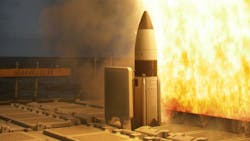RTX Raytheon to provide certified parts for SM-3 missile-defense interceptor with infrared seeker
HUNTSVILLE, Ala. – Missile-defense experts at RTX Corp. will provide RIM-161 Standard Missile 3 (SM-3) Block 1B parts to help the missiles acquire, track, and destroy incoming ballistic missiles under terms of a $99 million contract announced last week.
Officials of the U.S. Missile Defense Agency (MDA) in Huntsville, Ala., are asking the RTX Raytheon segment in Tucson, Ariz., to procure and deliver SM-3 Block IB parts that are manufactured, assembled, and tested in accordance with the SM-3 Block IB specifications.
Hit-to-kill ballistic missile defense interceptor
The Standard Missile-3 is a U.S. Navy hit-to-kill ballistic missile defense interceptor designed to destroy short- to intermediate-range ballistic missiles. It uses an exoatmospheric kill vehicle that crashes into the incoming ballistic missile target during its mid-course phase in space.
The massive collision of the kill vehicle hitting its target obliterates the incoming ballistic missile and its warheads, Raytheon officials say; explosives are not necessary. The resulting impact is the equivalent of a 10-ton truck traveling at 600 miles per hour.
The Standard Missile-3 can be launched from land sites as well as from specially equipped Navy Aegis destroyers and cruisers. The Standard Missile-3 Block IB has an enhanced two-color infrared seeker and upgraded steering and propulsion capability that uses short bursts of precision propulsion to direct the missile toward incoming targets.
The SM-3 Block IB interceptor has an enhanced two-color infrared seeker and upgraded steering and propulsion capability that uses short bursts of precision propulsion to direct the missile toward incoming targets, RTX Raytheon officials say. It became operational in 2014, deploying for the first time on U.S. Navy ships.
SM-3 Block IIA has large rocket motors
The SM-3 Block IIA, meanwhile, is in cooperation with Japan for deployment on land and at sea. It has larger rocket motors than its predecessors that will enable it to defend broader areas from ballistic missile threats and a larger kinetic warhead than previous versions.
On last week's contract, RTX Raytheon will do the work in Tucson, Ariz., and should be finished by March 2026. For more information contact RTX Raytheon online at www.rtx.com/raytheon, or the Missile Defense Agency at www.mda.mil.
About the Author
John Keller
Editor-in-Chief
John Keller is the Editor-in-Chief, Military & Aerospace Electronics Magazine--provides extensive coverage and analysis of enabling electronics and optoelectronic technologies in military, space and commercial aviation applications. John has been a member of the Military & Aerospace Electronics staff since 1989 and chief editor since 1995.
